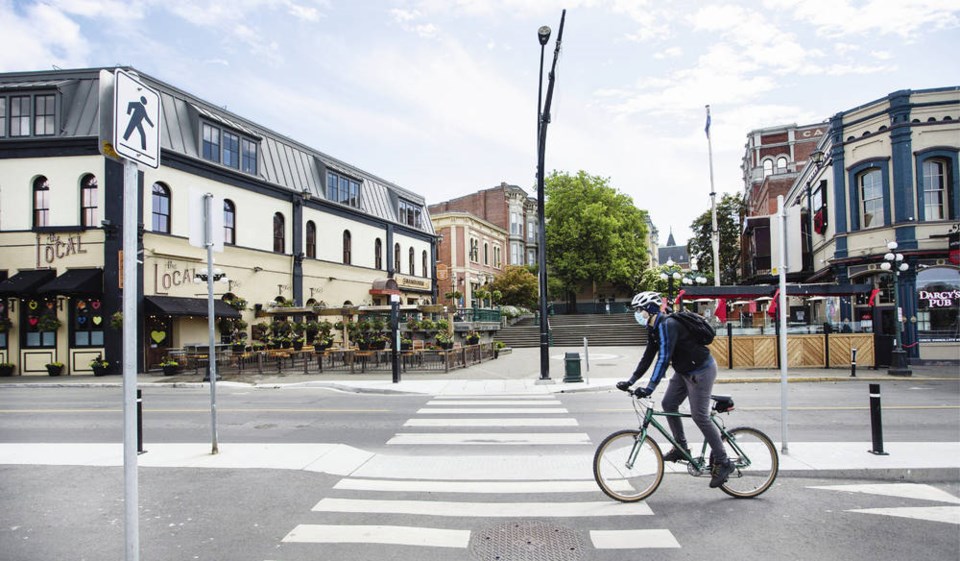With Step 3 of sa���ʴ�ý’s COVID-19 restart plan in force, more is happening on our streets than we’ve seen since early 2020. More employees are trekking to and from the office, people are now meeting to socialize, and travellers have hit the highways.
Although rush hour doesn’t yet equal pre-pandemic levels, vehicle traffic is noticeably increasing.
And with that increase, the associated pollution is also rising.
During the early pandemic lockdowns, clearer skies and cleaner air resulted from empty roads. Even the Lower Mainland’s tongue of yellow haze that regularly stretches across the strait withdrew.
NASA tracked the drop in atmospheric pollution during those months, including here on the coast. Elsewhere, cities that typically stew in smog saw crisp blue skies.
A study published in The Lancet Planetary Health in October reported that lockdown air-quality improvements averted tens of thousands of deaths in regions of Europe and China where air pollution usually chokes the skies and adds to the annual death toll. In particular, concentrations of micro-particulate matter — airborne particles smaller than 2.5 microns in diameter or less than 1/30th the width of a human hair — dropped an unprecedented 30 per cent in China and 17 per cent in parts of Europe.
Poor air quality — in particular, levels of nitrogen dioxide, ozone, benzene, polycyclic aromatic hydrocarbons, and soot and other particulates, all of which are associated directly or indirectly with motor vehicle emissions — contributes to incidence and severity of respiratory disease, heart disease, stroke, hypertension and Type 2 diabetes.
Childhood exposure to air pollution has been linked to a possible increased incidence of neurological disorders such as bipolar disorder, schizophrenia and severe depression, while University of British Columbia researchers reported last year that people who live near major roads or highways may face increased risk of dementia, Parkinson’s, Alzheimer’s and multiple sclerosis.
In its 2021 report on the health impacts of air pollution, Health sa���ʴ�ý estimates that air pollution contributes to 15,300 premature deaths each year in sa���ʴ�ý. Across the country, non-fatal health effects include 2.7 million asthma-symptom days and 35 million acute respiratory-symptom days every year.
The total annual economic cost of health impacts attributable to air pollution equal $120 billion (in 2016 dollars), about six per cent of sa���ʴ�ý’s 2016 real gross domestic product.
Early in the pandemic, asthma in particular was identified as a risk factor for hospital admission and death from COVID-19. Because respiratory viral illnesses tend to trigger asthma attacks, it also was expected that the number of asthma cases requiring emergency treatment might increase during the pandemic.
But that didn’t happen.
Personally, three acquaintances who have severe asthma have each related to me that they did not need to use their inhalers even once from March to mid-July last year, during the first months of the pandemic lockdown. It was only when traffic started revving up again in their regions or, in one case, smoke from wildfires wafted north that their reliance on inhalers returned to “normal.”
These are only three people, and their stories are anecdotal. Their reported experiences are interesting but not necessarily representative. No information comparing rates of hospitalization due to asthma before and during the lockdown have been reported for sa���ʴ�ý, but some studies elsewhere suggest fewer people may have needed emergency or hospital care for asthma during that period.
Three papers published in the medical journal Thorax document fewer patients with severe attacks seen by family doctors or admitted to hospital during the pandemic, and fewer admitted to hospital for chronic lung diseases, including asthma.
In the weeks after the early pandemic shutdowns, the number of people experiencing asthma attacks that resulted in emergency hospital admission fell by more than one-third in each of England and Scotland, although the number of deaths due to asthma didn’t vary significantly. In Korea, the pandemic was associated with a fall in hospital admissions for asthma, pneumonia, influenza and chronic obstructive pulmonary disease.
Stay-at-home directives and fear may have kept some asthma patients from seeking medical help. Warnings regarding asthma increasing vulnerability for severe COVID-19 may have prompted patients to pre-emptively fill their asthma prescriptions.
It’s also been shown that the travel restrictions and limited social contact reduced air pollution and transmission of other respiratory viruses. That may have reduced cases of asthma attacks.
It could be all three factors combined.
The brief experience with clean air by asthma sufferers may be one of the few bright spots, as it were, of the early pandemic lockdowns.



